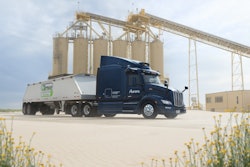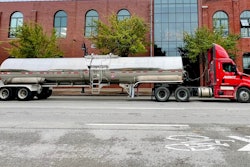Most fleets use digital mapping and mileage databases in their management systems to generate routes and directions for drivers on demand. A few fleets are beginning to use in-cab, turn-by-turn navigation systems to create safe and legal routes for various truck attributes, such as 53′ trailers and hazardous loads.
Truck manufacturers are also beginning to offer truck-specific navigation systems in their latest truck models. The leading suppliers of the digital map data used for all these applications are working on a radically different concept, however. In the near future, digital map data will be imbedded with vehicle controls, they say.
In recent interviews with CCJ, Tele Atlas and Navteq both said they are working with truck makers to develop advance driver assistance systems (ADAS).
“We’re talking to about every truck manufacturer. We have research programs ongoing. Everyone is investigating this,” says Bob Denaro, vice president of advance driver assistance systems for Navteq.
If seatbelts, airbags and re-inforced cabs were the first wave of safety, “The next wave is active safety,” he says. “Instead of mitigating damage and protecting the driver in the case of an accident, you try to avoid it altogether.”
The Tele Atlas Logistics Database, for example, provides detailed road attribute information specifically targeted to operators of large vehicles. As one of the largest providers of digital map data and dynamic content, TeleAtlas is now working with several truck OEMs on a breakthrough concept called assisted driver systems, says Dana Fenner, Tele Atlas’ Fleet Director.
“These are systems that are built into the integration and hardware of the truck,” Fenner says. By contrast, today’s navigation systems require user intervention; assisted driver systems are built into the vehicle and do not require user interaction to operate.
In developing assisted driver systems, truck OEMs are looking to use attributions in mapping databases such as slopes on roads to create “predictive cruise control,” for example. Imagine a vehicle on cruise control that automatically knows when and how much to accelerate before approaching a hill and when to decelerate before going downhill.
“It is a safety issue,” Fenner says. “It takes cruise control to the next step. The attribution of the map is able to be integrated with truck components to automatically do those type of things.”
Besides safety considerations, integrating map attributes into the vehicle’s electronics for predictive cruise control can generate fuel savings, he adds. Navteq’s Denaro says that simulation studies show a two to six percent fuel improvement by knowing the slope.
OEMs are also starting to look into road curvature attributes as well. A vehicle could prevent a rollover situation by automatically slowing down based on the location of a curve on a particular road, and include the weight and configuration of a truck in its split-second calculations.
TeleAtlas’ Logistics Database also contains multiple lanes on a road, making it possible–through the use of GPS–to aid drivers with lane warnings if they move out of a truck-specific lane, Fenner says. Fenner says that the trucking industry will start to see some announcements about assisted driver systems from TeleAtlas and from truck OEMs in the first quarter of 2008. He expects that slope attributes will be the first attribute to be incorporated into assisted driver systems.
“OEMs have been working on this for three to four years,” he says. The level of detail and accuracy of attributes built into the street network has increased over this timeframe as the accuracy of TeleAtlas’ data collection methods and technology to measure the elevation of roads has been fine tuned, he adds.
The mobile mapping vans TeleAtlas uses to collect this data have a GPS collection system that took a year to get approval to use from the Department of Defense. The system uses the same GPS device as the Patriot Missile defense system, he says.
“Our accuracy supersedes the required accuracy from OEMs,” Fenner says. “We have less than 1 percent deviation from reality.”









